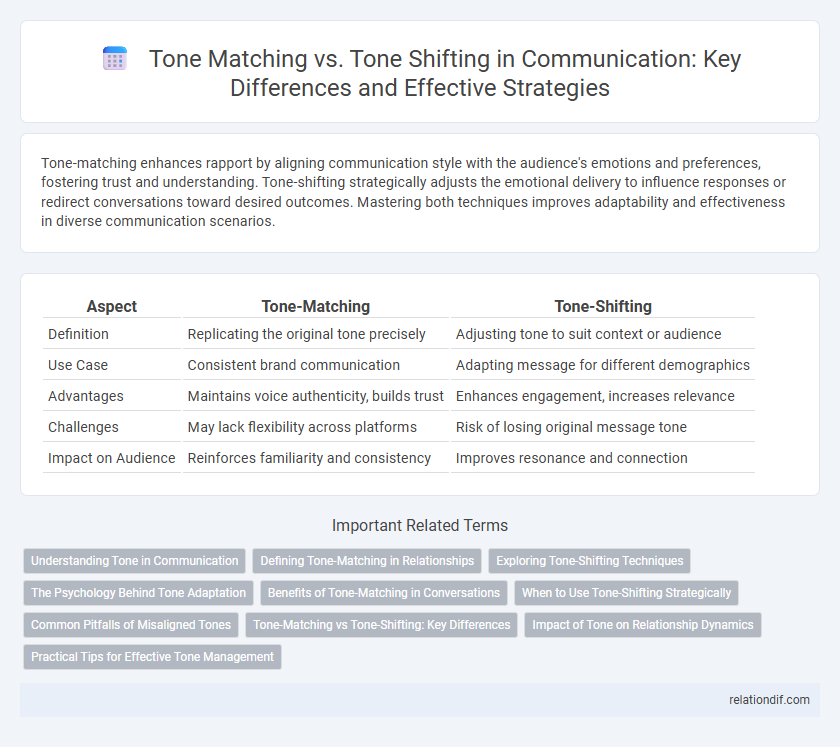Tone-matching enhances rapport by aligning communication style with the audience's emotions and preferences, fostering trust and understanding. Tone-shifting strategically adjusts the emotional delivery to influence responses or redirect conversations toward desired outcomes. Mastering both techniques improves adaptability and effectiveness in diverse communication scenarios.
Table of Comparison
| Aspect | Tone-Matching | Tone-Shifting |
|---|---|---|
| Definition | Replicating the original tone precisely | Adjusting tone to suit context or audience |
| Use Case | Consistent brand communication | Adapting message for different demographics |
| Advantages | Maintains voice authenticity, builds trust | Enhances engagement, increases relevance |
| Challenges | May lack flexibility across platforms | Risk of losing original message tone |
| Impact on Audience | Reinforces familiarity and consistency | Improves resonance and connection |
Understanding Tone in Communication
Understanding tone in communication involves recognizing when to employ tone-matching, which aligns your emotional expression with the other person's feelings to build rapport and trust. Tone-shifting, on the other hand, requires adjusting your vocal attitude to guide conversations, de-escalate conflicts, or influence outcomes effectively. Mastering both techniques enhances clarity, emotional intelligence, and connection in interpersonal interactions.
Defining Tone-Matching in Relationships
Tone-matching in relationships involves consciously aligning your vocal pitch, pace, and emotional expression with the other person's communication style to foster empathy and understanding. This technique helps create a sense of connection by mirroring the other individual's mood and energy, which can enhance rapport and reduce misunderstandings. Effective tone-matching requires attentiveness and adaptability to respond authentically without losing personal sincerity.
Exploring Tone-Shifting Techniques
Tone-shifting techniques involve strategically adjusting vocal pitch, pace, and volume to align with different conversational contexts, enhancing message clarity and emotional impact. By recognizing the audience's mood and communication style, speakers can effectively shift tone to foster rapport, reduce misunderstandings, and drive engagement. Mastering tone-shifting requires practice in empathy, active listening, and adaptive speech patterns to create dynamic and persuasive interactions.
The Psychology Behind Tone Adaptation
Tone adaptation in communication hinges on psychological principles such as empathy and social cognition, enabling individuals to either mirror (tone-matching) or modify (tone-shifting) their vocal expressions to align with interlocutors' emotions and social contexts. Tone-matching fosters rapport and trust by creating a sense of mutual understanding and emotional resonance, while tone-shifting demonstrates flexibility and situational awareness, facilitating effective communication across diverse audiences. Mastery of tone adaptation strategies enhances interpersonal effectiveness by balancing emotional attunement and contextual appropriateness.
Benefits of Tone-Matching in Conversations
Tone-matching in conversations enhances rapport by creating a sense of understanding and empathy, which can lead to increased trust and cooperation. It facilitates smoother communication, reducing misunderstandings and making interactions more engaging and effective. Employing tone-matching techniques helps align emotional states, promoting a positive conversational atmosphere and stronger interpersonal connections.
When to Use Tone-Shifting Strategically
Tone-shifting can be strategically used in communication to adapt the message according to the audience's emotional state or the context of the conversation, enhancing receptivity and engagement. For example, shifting from a formal tone to a more empathetic tone when addressing customer concerns builds trust and rapport. Effective tone-shifting requires awareness of situational cues and the goal of fostering positive interaction without losing message clarity.
Common Pitfalls of Misaligned Tones
Misaligned tones in communication often lead to misunderstandings, as tone-matching ensures emotional resonance while tone-shifting can confuse the recipient's expectations. Common pitfalls include perceived insincerity, reduced trust, and message distortion, which hinder effective interaction and collaboration. Mastering appropriate tone adjustment is critical for maintaining clarity and rapport in both personal and professional exchanges.
Tone-Matching vs Tone-Shifting: Key Differences
Tone-matching involves mirroring the emotional intensity and style of the other person's communication to build rapport and foster trust. Tone-shifting, by contrast, requires adjusting your tone intentionally to influence the conversation's direction or to de-escalate tension. Understanding when to apply tone-matching versus tone-shifting enhances communication effectiveness in both personal and professional interactions.
Impact of Tone on Relationship Dynamics
Tone-matching fosters trust and empathy by reflecting the emotional state of the conversation partner, which strengthens relational bonds and promotes mutual understanding. In contrast, tone-shifting can either create positive influence by guiding the emotional flow or cause misunderstandings if perceived as insincere or manipulative. The strategic use of tone directly impacts communication effectiveness, emotional connection, and the overall dynamics within personal and professional relationships.
Practical Tips for Effective Tone Management
Tone-matching involves mirroring the communication style and emotional intensity of the other person to build rapport and foster understanding. Tone-shifting strategically adjusts your vocal expression to guide conversations toward desired outcomes, such as diffusing tension or emphasizing key points. Practical tips include actively listening to identify cues, modulating pace and volume accordingly, and practicing adaptive responses to maintain clarity and engagement.
tone-matching vs tone-shifting Infographic

 relationdif.com
relationdif.com